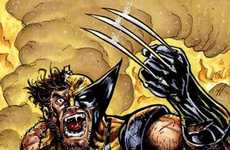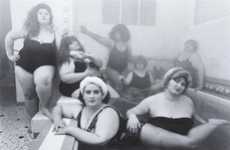Retro: Kimmer |  |
| NACHO'S STORY WRITTEN BY FLIGHT SURGEON DENIZ TEK Posted: 01 Sep 2011 03:18 PM PDT  Kimmer Deniz and Anne Laurent Kimmer Deniz and Anne Laurent Just a short note from Kimmer tonight... I met Deniz Tek in October of 2009 due to our mutual friends.. Well Deniz and I have really learned so much about online entertainment and promotion. Deniz is the most fascinating man. A Navy Flight Surgeon/Guitarist/Songwriter Arranger/Painter/Photographer/Sculptor/ER Surgeon/and oh yes... movie star handsome... Deniz however is very grounded and loves to find new ways to achieve his goals... With that in mind Deniz and I connected. So my latest idea came from associates that suggested I ask my celebrity friends to write for Retrokimmer.Com... Great Idea! We started with Scott Morgan on Sundays and now we are adding Deniz on Thursdays. So here is our first post from Deniz Tek... Strap yourselves in... it's going to be a bumpy ride... I was in Yuma Arizona for a WTI course. WTI is the acronym for "Weapons and Tactics Instructor Training". WTI is run by the Marine Corps, and it teaches students how to plan, coordinate and execute air support for an amphibious landing. It is like Topgun, which teaches fighter tactics but has a much broader scope. The students come from squadrons all over, and once qualified, bring their expertise back to their units. WTI has a range out in the desert with telemetry so that everything that happens out there gets monitored and recorded for later analysis.  I was there as the course flight surgeon, so I was not officially a student but I attended all the classes and flew as often as possible. The training area in the Chocolate Mountains is fantastic. They have all sorts of targets out there, including truck convoys, trains, mock air bases ... like the coolest video game ever, but with all real stuff. The area is restricted, because live fire is used. Every once in a while, some hapless person gets blown to bits out there scavenging for stuff. I was there as the course flight surgeon, so I was not officially a student but I attended all the classes and flew as often as possible. The training area in the Chocolate Mountains is fantastic. They have all sorts of targets out there, including truck convoys, trains, mock air bases ... like the coolest video game ever, but with all real stuff. The area is restricted, because live fire is used. Every once in a while, some hapless person gets blown to bits out there scavenging for stuff.  Phantom Phantom It's hot in Yuma in the summertime. I recorded a temperature of over 150F under the canopy of a Phantom jet waiting in the bomb arming area by the runway prior to takeoff (the Phantom's AC doesn't kick in until you are flying). Marines are always running when they are not working, and you'd see guys coming back from runs around the base covered in white dust. That white crusty powder was salt from their bodies, where the sweat had instantly evaporated hitting the hot bone dry air.  It was during the final exercise. We had already lost a Hughes 500 helicopter early in the course, and I was hoping for no more crashes. I was in the CIC when the call came. "Base, we got an A4 Mike down out here. Fireball, no ejection, no chute." At that point a flash message goes up the chain to higher headquarters, and the next thing that happens is that the crash investigation team assembles. That always includes the flight surgeon, the safety officer, and others. We jumped in a 46 (Sea Knight helicopter) and headed out to the crash site. There was none of the usual joking conversation. I was full of dread. We knew from the other aircraft that had observed (and even filmed) the crash that the pilot had not ejected. We expected to be picking up body parts, maybe of a friend. I went over procedures with the safety officer. He himself had once been in a crash, having ejected from an A4 after a midair collision. He had little round scars on his forehead, where traction pins had been inserted. I noticed that one of his flight boots was built up a couple of inches to compensate for that leg being shorter, due to a smashed femur. We came up over a ridge line in the desert and saw a column of black smoke in the hazy distance. As we got close and circled the site, I saw that everything was on fire. Rocks, sand, cactus, little scrub mesquites ... all burning. Twisted and torn shiny aluminum airplane parts were strewn across the desert floor, catching the painfully bright sunlight. As we flared to a hover and landed, the crew chief said on the intercom: "Sir! Sir! There's a guy sitting over there at our 3 o clock!" Sure enough, as the swirling dust from the rotor wash cleared, there WAS a guy sitting on a rock. The pilot had his helmet on his knee, and when our helicopter landed, he put his helmet back on, stood up, and ran to the door. He climbed in, strapped in, and gave us a "thumbs up". He then passed out. He would not wake up again for the next three days. The patch on his flight suit said that his call sign was Nacho. We took off again, and flew him to the hospital in Yuma. I attended to him on the way there. He had a concussion, and had been partially scalped. An ear was hanging by a thread. There were third degree burns on both forearms, where he had rolled up the sleeves of his fireproof Nomex flight suit. And he had some minor spinal fractures. I left him in the care of the duty physician at the hospital and we left to go back to the crash site. The scene was a vision from hell. There were still little fires burning everywhere. The smoking engine was the biggest intact part out there, everything else was shredded. We found the ejection seat on top of a crushed mesquite tree, a hundred meters from the rest of the wreckage. The parachute shroud lines were tangled up in the tree, the ripped chute nylon trailing in the wind like a flag. The seat had not fired, but had been ripped off the rails. Walking around the area, I found a little airline bottle of Bushmill's Irish Whisky. I put it in my pocket.  When we reviewed the film, and put together all the evidence, it was clear that a one-in-a-zillion miracle had occurred. Nacho was on a bombing run on a train. As he approached the target, he got too low. His jet hit the train, crosswise, probably doing around 400 knots. The Skyhawk split into two fireballs, diverging from the impact. It seems that as the jet was ripped in two, the seat with Nacho in it was torn out of the cockpit and flew through the wreckage, the parachute coming out along the way. The trajectory of the seat took it to a landing on its back on top of a mesquite tree, crushing the gnarly branches down and providing for some cushioning effect. Nacho must have unstrapped and climbed down, and sat on that rock, and waited. He does not remember anything that happened after he took off that day. When we reviewed the film, and put together all the evidence, it was clear that a one-in-a-zillion miracle had occurred. Nacho was on a bombing run on a train. As he approached the target, he got too low. His jet hit the train, crosswise, probably doing around 400 knots. The Skyhawk split into two fireballs, diverging from the impact. It seems that as the jet was ripped in two, the seat with Nacho in it was torn out of the cockpit and flew through the wreckage, the parachute coming out along the way. The trajectory of the seat took it to a landing on its back on top of a mesquite tree, crushing the gnarly branches down and providing for some cushioning effect. Nacho must have unstrapped and climbed down, and sat on that rock, and waited. He does not remember anything that happened after he took off that day. I went to see him in the hospital. Some squadron mates were there, and a whole bunch of guys had been coming around and rubbing his head to try to get hold of some of his incredible luck. I said "I think you lost this" and tossed him the bottle of Bushmill's. He was so glad to get it back ... he said he always kept it in his flight suit so if he ever had to eject, he'd have something to drink while awaiting rescue.  He eventually made a full recovery and went back to flying. I went and visited him and his wife a year or so later. We drank beers, sat on the patio, and had dinner at their house. There is a plaque on his wall that the squadron made for him, with a mount of a model train with a model of an A4 stuck through it. It is a great thing to have on your wall. Nacho said he's not sure what brought him so much luck that day, but he never takes off without that little bottle of Bushmill's whisky. He eventually made a full recovery and went back to flying. I went and visited him and his wife a year or so later. We drank beers, sat on the patio, and had dinner at their house. There is a plaque on his wall that the squadron made for him, with a mount of a model train with a model of an A4 stuck through it. It is a great thing to have on your wall. Nacho said he's not sure what brought him so much luck that day, but he never takes off without that little bottle of Bushmill's whisky. |
| You are subscribed to email updates from Retro: Kimmer To stop receiving these emails, you may unsubscribe now. | Email delivery powered by Google |
| Google Inc., 20 West Kinzie, Chicago IL USA 60610 | |













































































